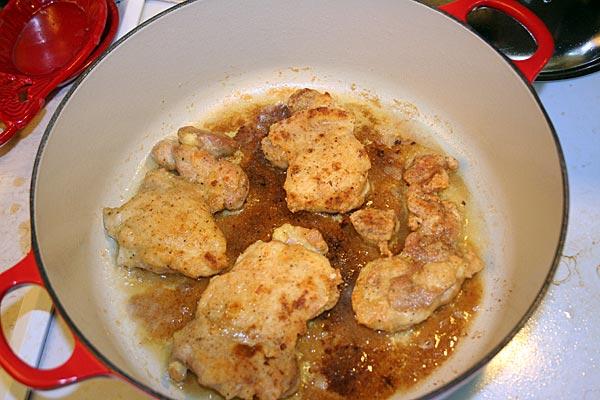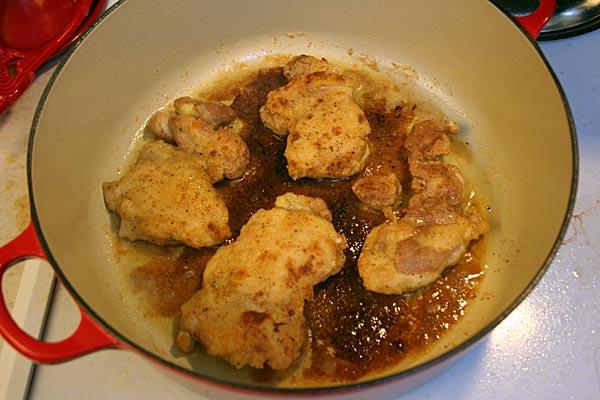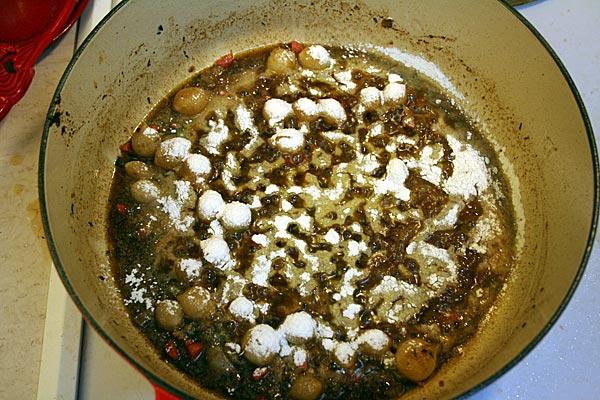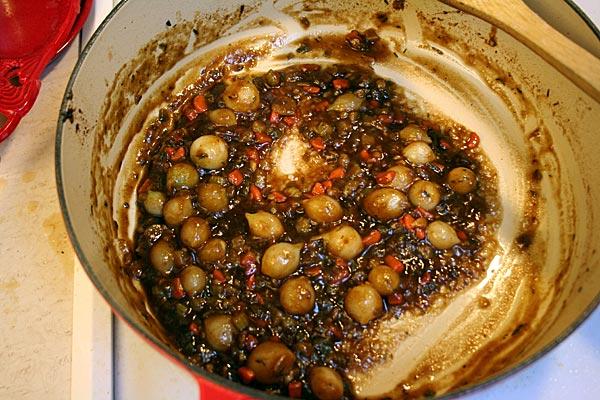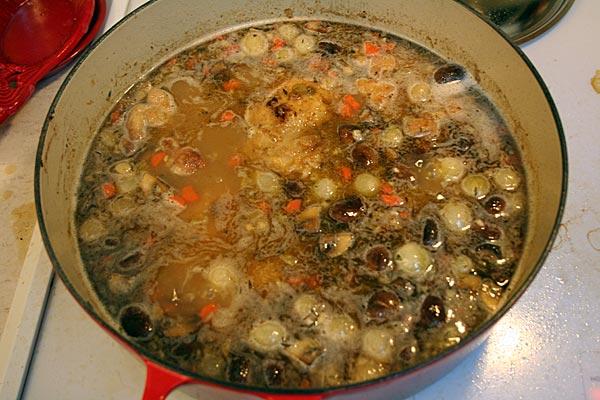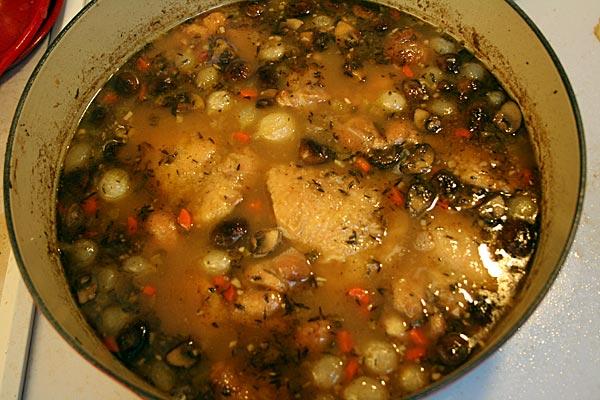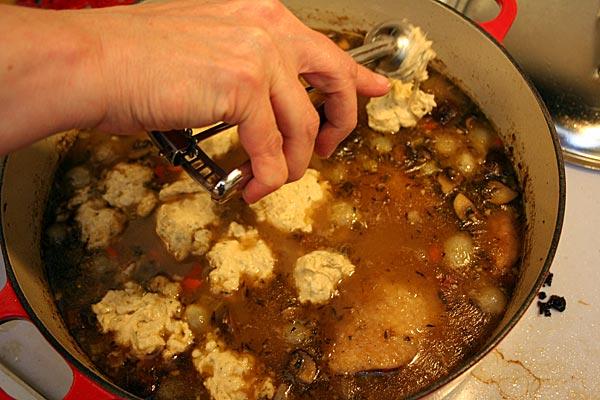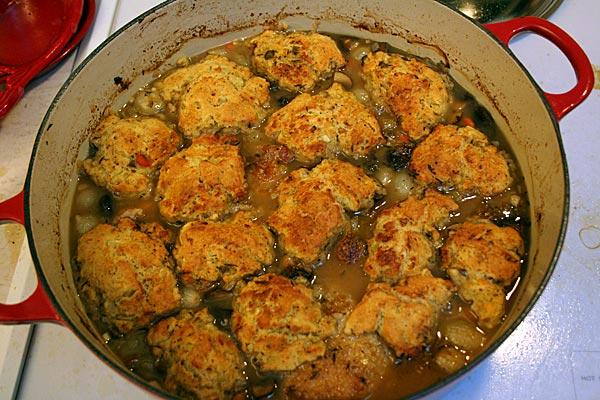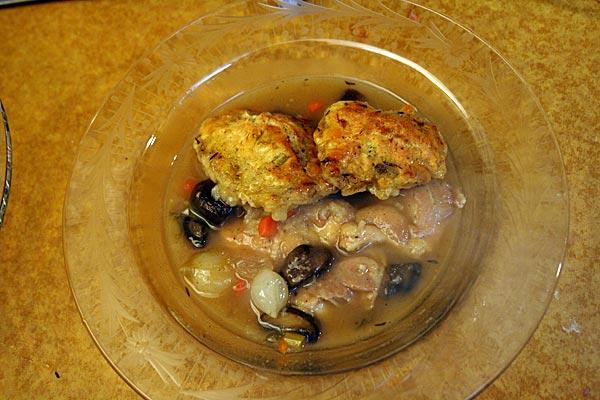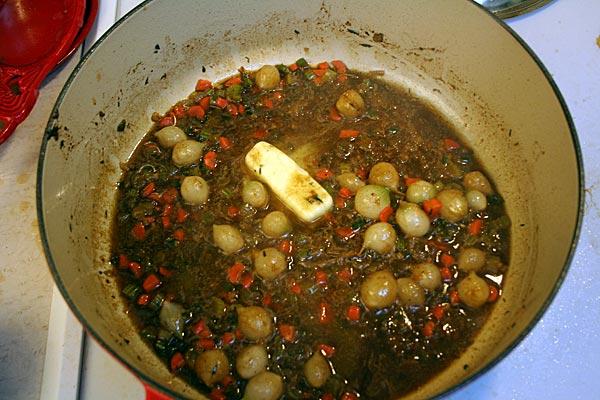-
Posts
8,089 -
Joined
-
Last visited
Content Type
Profiles
Forums
Store
Help Articles
Everything posted by Dave the Cook
-
That's a sweeping statement, dhardy123. Olive oil comes in lots of grades, and they're useful for different things. That special extra-virgin that you keep just for vinaigrettes and finishing probably deserves pampering. On the other hand, I've found decent, if not great, EVOO in clear glass bottles. It's fine for shallow frying and sauteeing, where the fruitiness comes through but subtleties of a kid-gloves-handled, terrior-soaked, $30-a-pint oil would be wasted.
-
There are a couple of advantages to IQF. The first is portion control. I usually have a bag in my freezer, and I can pull out only what I need for a meal, rather than run to the market for 6 to 12 ounces of "fresh." Second is the whole idea of "fresh." Chances are, as Celeste indicates, shrimp purchased anywhere other than right off the dock or very close to it has already been frozen -- sometimes twice. February is not a great month for shrimping, anyway (I'm pretty sure it's out of season in Louisiana until April or May), which is probably why KennethT is encountering shortages. So chances are that stuff that appears to be fresh is really just defrosted. Some states require it to be labeled as such. Further to the second point, shrimpers stay out anywhere from one to five days, stowing their catch on ice until they dock. The concept of freshness under such conditions must allow for some flexibility. Add a day or two to ship unfrozen product to a market like New York and you're looking at a shrimp that could easily be a week old.
-
There's a more comprehensive smoke-point chart here. Note that refined oils have higher smoke points than their unrefined counterparts mostly because you're removing fine particles suspended in the raw product; these are what burns and cause smoking. Wombat3788 is correct that extra-virgin olive oil isn't appropriate for deep frying, but that's also true for most unrefined fats. Refining not only increases the smoke point, it makes oils more bland in flavor, so as you go up the scale, the type of oil you use for frying becomes less important from a flavor standpoint. On the other hand, I couldn't count the number of Mario Batali recipes that start by heating extra-virgin olive oil to smoking, and he seems to be doing okay with this cooking thing. As for health, much depends on which side you're on in the cholesterol hypothesis debate.
-
I came across two interesting things the other day, though I purchased neither, deciding to wait and hear from folks here first. One was "S & L Cristiani Maraschino." Until that moment, I didn't think anyone besides Stock, Luxardo and Maraska made maraschino. Anyone know about this other stuff? It was a couple of bucks cheaper than Luxardo. The other was a group of Doorly's rum bottlings; several ages and colors, 80 and (IIRC) a 151. It was all suspiciously inexpensive. What's the story here?
-

Helping your non-foodie friends set up a kitchen
Dave the Cook replied to a topic in Kitchen Consumer
D'oh! I should have thought of this sooner. We (JAZ and I) teach a three-day/once-a-quarter class for beginning cooks. In the first few rounds, we got lots of questions about equipment. Based on our experience, supplemented with lots of information gathered from eG Forums, we came up with the following: -
I haven't spent a lot of time in Columbus, but I have this from a very astute relation whose judgment I trust:
-
There's a decent photo of back ribs here. Some misguided meat peeps cut them into individual ribs. Don't bother with those, and don't bother with the ones vice describes, where the meat has been carved out for whatever reason. (And complain to your meat peep -- they do listen.) I could see taking the smallest two or three (connected to each other) and making a meal of them; you're getting rib-steak meat there. Ellen: sugar (any sugar: white, brown, turbinado, muscovado, demerara, dried cane juice, whatever) burns at 350F. That's why my recipe starts out there and descends. The oven is such an inefficient heating vessel that the sugar in the rub doesn't get hot enough to burn; with luck (and a well-calibrated oven), it just caramelizes a bit. Having said that, I don't think you'd be risking too much in reversing the operations (or subbing turbinado, or both). There's a chance that the sugar will combine with meat juices and roll off, but I think it's minimal, and well worth trying. If the result lacks a bit of balanced sweetness, just up the sugar next time. You'll still have a delicious rib.
-

Looking for Small Commercial Cinnamon Grinder/Mill
Dave the Cook replied to a topic in Kitchen Consumer
How about the Ultra-Pride? -
They do have a lot of connective tissue -- it's just that when you slice the roast, you sever those tissues into short fibers, so they seem less chewy. McLagan has three rib recipes, two of which call for separate ribs, meaning those connective tissues will be pretty short. One also calls for ribs left over from a roast, which is why they can be done so quickly. Her third recipe -- using racks -- takes quite a bit longer: an hour, plus resting time. Personally, I object to all of these recipes, and I think McLagan is plain wrong on a couple of points. Beef ribs, done properly, will not cook in half the time of pork or lamb; and they have just as much fat. I also disagree with her notion that you shouldn't cook them further than medium rare. At that point, they will be very tasty, but also tough and unpleasantly chewy (unless, of course, you've used individual ribs, which I think is sacrilegious). I also don't think it's a good idea to ruin that nice beefy crust with a wet sauce. Glazes can be okay, but with all that ketchup, vinegar, Worcestershire and corn syrup, McLagan just drowns the beef with an uncomplimentary sweet and sour mess. Here's what I do. Make a rub: 1 tablespoon whole black peppercorns 1 tablespoon whole cumin seeds 2 tablespoons sweet paprika 2 tablespoons ground ancho 4 teaspoons packed dark brown sugar 1 teaspoon smoked salt 1 teaspoon kosher salt (I use Diamond Crystal; if you've got Morton's, use a little less; for table salt, use about half) 1 teaspoon smoked paprika Toast the peppercorns and cumin in a dry pan over medium low heat just until fragrant. Remove from the heat, allow to cool, then grind fine along with the brown sugar (in order to break it up). Combine the pepper, cumin and sugar with the rest of the rub ingredients in a shaker. Shake the rub over the ribs and pat to help it adhere. Flip the ribs and repeat on the other side. Let rest, lightly covered at room temperature for an hour or so, or wrap tightly in plastic wrap and refrigerate overnight. Heat the oven to 375˚F. Put the ribs meat-side up on a rack over a roasting pan or sheet pan. Put the ribs in the oven. After 15 minutes, turn the oven down to 250˚F. After an hour, flip the ribs and cook for another hour. Flip again, and check at 30 minutes. The meat should have started to shrink from the ends of the bones, and the rack itself should be getting flexible. The ribs are done when the meat has drawn back about an inch, the rub has become one with the meat surface to form a nice crust, and the rack is floppy. Let them rest ten to fifteen minutes. Slice into two-rib portions, with a half-cut between the two for ease of eating. On this one point, I agree with McLagan: have plenty of napkins on hand.
-
The liquor stores I frequent (in Atlanta) have been out of Angostura for several weeks. Luckily, grocery stores still have ample supplies.
-
Nice dish, David, though it seems to me that it's more like creamed chicken than the a soup-like concoction normally associated with C&D (said the guy who browned his dumplings!) It's obvious you've done some research. Is there an historical basis for this sort of modification?
-
Sugar is sugar, regardless of the source. I've seen the throwback stuff around here (Atlanta). It's priced the same as the other Pepsi products: three 12-packs for $10.
-
I made this last night, and it was excellent. Here's the step-by-step, more or less. I used seven skinless-boneless thighs, because bone-in just seems needlessly messy, and I don't find boiled chicken skin very appealing. It also meant that there would be less fat to deal with (not that I have anything against chicken fat, but, well, you'll see). The chicken is seasoned with salt, black pepper and cayenne, then dredged in flour and browned: Link says to brown on medium-high; I ended up going for a notch below medium, since my cooktop seems to run hot. I also didn't want to scorch the pepper, and since it took two batches, I didn't want to burn the fond. You're shooting for a light golden-brown: The chicken comes out, and a standard mirepoix (surprisingly, not trinity, and I subbed pearl onions for chopped) goes in to tenderize and color a bit, along with fresh thyme and the seasoning that didn't get used on the chicken. (The mushrooms are sauteed separately and added.) Deglaze with white wine, then add butter: toss in some flour: Stir to make a roux: Put the chicken back in the pot and add stock. Bring it to a simmer and cook for about an hour, by which time, a fair amount of fat has risen to the top: I didn't take photos of the defatting; the simple application of two or three paper towels to the surface did the trick: The dumplings were made ahead so they could rest in the fridge (Link says at least 30 minutes). It's a standard dumpling recipe with an egg added, as well as onion, cayenne and dried oregano. Link calls for quenelles, but I just used a scooper: Then it goes uncovered into a 450 F oven for 20 minutes. The dumplings rise and brown: Bad choice of background (an Epicurean cutting board that almost exactly matches color of the broth), but here's the plated dish: This was terrific. Despite the biscuit-like crunch from the browned tops, the dough underneath remained soft and fluffy, with the bottom layer absorbing the broth nicely. The broth was rich and slightly spicy, and the chicken fork-tender. I'm glad I didn't use the whole chicken, which is how the recipe is written. I can't imagine a breast surviving an hour and a half of stewing with great results. The restaurant origins of the recipe become clear in the making: it calls for cooking the chicken in a skillet, then transferring to a Dutch oven; the separate mushroom step. Having said that, it's an easy dish with a high reward-to-effort ratio.
-
I'm in. As a starting point, I'll use the recipe from Donald Link's Real Cajun. I know it's been on the menu at Herbsaint (one of his NOLA restuarants) now and again -- or maybe constantly -- but despite having been there a few times, I've never tried it. A couple of things distinguish it, I think -- though I'm hardly a C & D expert: a robust dumpling flavored with oregano and cayenne; what might be considered non-standard ingredients in the stew: mushrooms, white wine, jalapeno and cayenne; a final oven step that browns the top of the dumplings.
-
Pressure cooker, using a flavorful liquid.
-
I just came home from the grocery store with a tub of Bob Evans' pre-made macaroni and cheese. All the guilt of the blue box and none of the mess.
-

Worse, Much Worse, Than You Remember: Acquired Distastes
Dave the Cook replied to a topic in Food Traditions & Culture
Rice Krispies now taste inedibly salty. -
Interesting that except for Charcuterie, which I agree is a great gateway book, we have none in common (that's about to change, as I'm one click away from buying the Aidells book). In my collection: The old-school Grigson, Charcuterie and French Pork Cookery Kinsella and Harvey's matter-of-fact Professional Charcuterie and two others that aren't entirely about charcuterie, but include significant sections: Preserved, by Nick Sandler and Johnny Acton Paul Bertolli's philosophical and engrossing Cooking by Hand
-
I am ashamed to admit that I do not own and have not read Mastering the Art of French Cooking, nor have I ever made a single recipe from either volume. I do not like olives or pickles (no, not even cornichons, though home-made quick pickles are okay). I use canned beef broth at least as often as I use stock (and no, I do not think plain water is better). Fess up here.
-
Seems like there are two easy ways to solve the inventory problem: Use them instead of vinegar more often!Start a cocktail habit. I hate to see a good cook using citrus powder. Why not buy a bag of lemons, juice them and freeze teaspoon-sized portions of juice in these mini-cube trays?
-
Just to be clear, the Chef's Choice won't accommodate a whole uncut pork belly either. However, once you trim the belly, squaring it up to a more or less commercial width (about seven inches), it works fine. I use the trim for batons and seasoning.
-
Dry scallops are essential. But I've caramelized scallops much smaller -- around an ounce each are what I can get reliably -- than the U-7s Keller likes (not that I wouldn't love to be able to get them). You just have to be fearless about the heat of the fat and trust your protein.
-
He uses giant scallops -- more than two ounces each -- and brines them. The scallops are laid out on paper towels, salted, then put in a pan with smoking-hot clarified butter. They cook for three to three-and-a-half minutes, until they caramelize. That's it. I don't see why you couldn't do it with regular sea scallops, though it won't work with little bays. The trick, if you want to call it that, is to let the scallop release from the pan on its own, then flip immediately, so as not to overcook them. If you can't get the giant specimens Keller can, the timing will be shorter -- about two minutes, in my experience.
-
I took a look at the recipe just now, and I suspect your problem has to do with heat control. Keller says to heat the oil over medium-high heat until the oil starts to smoke, then turn it down. This sequence ensures that 1) the pan will be hot enough to initiate browning; 2) that you won't experience a significant temperature drop when you add the fish; and 3) the surface of the fish will start to steam immediately, which will push oil away from the persillade. As soon as the crust starts to develop (Keller says about a minute), you remove it from direct heat and stick it in the oven to finish. The oil will still be hot enough to continue browning the crumbs; as that dissipates, the oven heat takes over. None of this will work if the oil isn't hot enough -- either because the cook hasn't brought it up to proper heat, or he crowds the pan (like Paul did one time), causing a temperature drop from which -- because the whole thing cooks so quickly -- he will not be able to recover.


